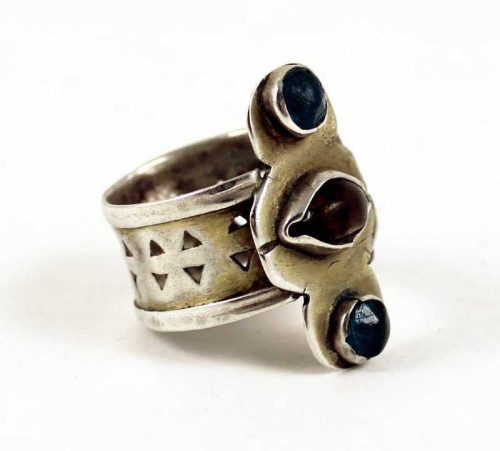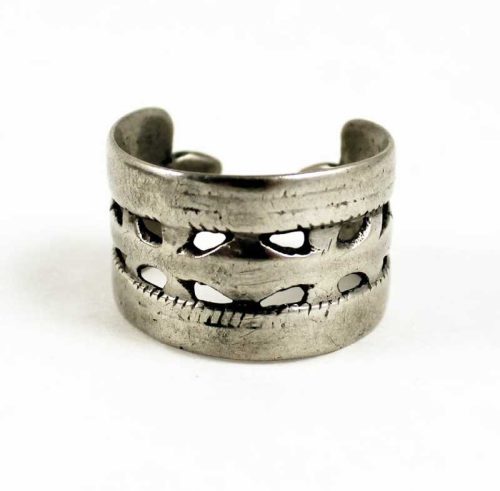-
A five-strand necklace that is usually worn in Southern Uzbekistan in an area where ethnic Uzbek, Tajik, and Pamir live. Made of silver, coral, shell and glass beads. Date: first half of the 20th century or earlier. Dimensions: Length: 84 cm Central pendant: 4,5 x 2 cm Weight: 179 gr Literature: “Schmuck aus Zentralasien”, Prokot, Inge and Joachim Callwey, Verlag München, 1981 “Il corallo. Nell’ornamento dell’Asia islamica dalla Turchia all’Uzbekistan”, del Mare, Cristina- Vidale, Massimo, Electa napoli, 2001 “Kyrgyzstan. Ethnic jewellery of Central Asia”, Kadyrov, V., Rarity Firm LTD, 2007 “De kracht van Zilver. Etnische sieraden uit de collectie smith hutschenruyter”, Mols, Luitgard, Wereld Museum, Rotterdam, 2011
-
Silver ring from Yemen (high grade silver). From the beginning of the 20th century or earlier. Provenance: European private collection. Size is US 6 - 16,5 mm inner diameter) Literature: “Bagues ethniques d'afrique, d'Asie et d'Amerique”, van Cutsem, Anne, Skira, 2000, p. 98 “Silver treasures from the land of Sheba”, Ransom. Marjorie, The American university in Cairo Press, 2014, p. 146 ME275
-
Silver ring from Yemen (high grade silver). From the beginning of the 20th century or earlier. Provenance: European private collection. Size is US 5 1/4 - 16 mm inner diameter) Literature: “Bagues ethniques d'afrique, d'Asie et d'Amerique”, van Cutsem, Anne, Skira, 2000, p. 98 “Silver treasures from the land of Sheba”, Ransom. Marjorie, The American university in Cairo Press, 2014, p. 146 ME276
-
Silver filigree ring from Yemen, with dangles to ward off the evil eye and one coral bead at the top of one of the domes (the other one is missing). Beginning of the 20th century or earlier Provenance: European private collection. Size is US 9 - 19 mm inner diameter. Literature: “Bagues ethniques d'afrique, d'Asie et d'Amerique”, van Cutsem, Anne, Skira, 2000, p. 98 ME279
-
Old Tekke ring, made of high grade silver . The whole ring has an old and worn patina. From the Turkoman people, Central Asia. From the first half of the 20th century. Provenance: UK private collection. Size: US 9 - 19 mm (inner diameter) Weight: 5,8 gr Literature: “The arts and crafts of Turkestan”, Kalter, Johannes, Thames and Hudson, 1983, p. 127 “Der Turkmenenschmuck”, Rudolph, Hermann, Museum für Völkerkunde, 1984, p. 251 “Bagues ethniques d’afrique, d’Asie et d’Amerique”, van Cutsem, Anne, Skira, 2000, p. 112 CA242
-
Silver ring, worn by Turkoman people, Central Asia. Materials: high grade silver, gilded silver, and glass. From the first half of the 20th century. Provenance: European private collection. Size: US 8 1/4 - 18,25 mm (inner diameter) Width of the top: 2,5 cm Literature: “Bagues ethniques d'afrique, d'Asie et d'Amerique”, van Cutsem, Anne, Skira, 2000, p. 112 “Schmuck aus Zentralasien”, Prokot, Inge and Joachim Callwey, Verlag München, 1981, p. 142 “Der Turkmenenschmuck”, Rudolph, Hermann, Museum für Völkerkunde, 1984, p. 251 “Old silver jewellery of the Turkoman”, Schletzer, Dietrich Reimer Verlag, 1984, p. 258 CA246
-
Silver ring, worn by Turkoman people, Central Asia. Materials: high grade silver, gilded silver, carnelian and glass. From the first half of the 20th century. Provenance: European private collection. Size: US size 9 - 19 mm (inner diameter) Width of the top: 3,5 cm Literature: “Bagues ethniques d'afrique, d'Asie et d'Amerique”, van Cutsem, Anne, Skira, 2000, p. 112 “Schmuck aus Zentralasien”, Prokot, Inge and Joachim Callwey, Verlag München, 1981, p. 142 “Der Turkmenenschmuck”, Rudolph, Hermann, Museum für Völkerkunde, 1984, p. 251 “Old silver jewellery of the Turkoman”, Schletzer, Dietrich Reimer Verlag, 1984, p. 258 CA248
-
Silver ring, worn by Turkoman people, Central Asia. Materials: high grade silver, gilded silver, carnelian and glass. From the first half of the 20th century. Provenance: European private collection. Size: US 8 1/4 - 18,5 mm (inner diameter) Width of the top: 3,5 cm Literature: “Bagues ethniques d'afrique, d'Asie et d'Amerique”, van Cutsem, Anne, Skira, 2000, p. 112 “Schmuck aus Zentralasien”, Prokot, Inge and Joachim Callwey, Verlag München, 1981, p. 142 “Der Turkmenenschmuck”, Rudolph, Hermann, Museum für Völkerkunde, 1984, p. 251 “Old silver jewellery of the Turkoman”, Schletzer, Dietrich Reimer Verlag, 1984, p. 258 CA245
-
High grade silver ring, worn by Turkoman people, Central Asia. From the first half of the 20th century. Provenance: European private collection. Size: US 11 - 20,75 mm (inner diameter), although it can probably be made a little bigger or smaller, as it is an open ring. Width: 1,5 cm CA231
-
Old silver earrings from the Yao people, one of the hill tribes living in the golden triangle hills on the border of Laos, Thailand and Myanmar and also the SW China hills. Mien and some Lahu also wear this bent arrow earrings. They have to be worn on extended earlobes holes. They have been decorated with blue enamel. High-grade silver. From 1st half of XXth century. The earrings are 3,2 cm high and 25 cm wide. Both of them weight 17 gr. The thickness of the widest part is 0,5 cm. Literature: “A world of earrings. Africa, Asia America”, van Cutsem, Anne, Skira, 2001, p. 232 “The Yao”, Pourret, Jess G., River Books, Bangkok, 2002, p. 162 “Peoples of the golden triangle”, Lewin, Paul and Elaine, River Books, Bangkok, 1998, p. 60 “The art of silver jewellery. From the minorities of China, the Golden Triangle, Mongolia and Tibet”, Skira, 2006, p. 191 SEA244
-
A silver amulet from Libya, in the shape of a cylinder and with vegetal and floral decoration etched and embossed on the surface. Some coral beads and small pendants intensify the amulet's power to ward off the evil eye. These containers usually hold written amulets or Ketiba in the form of verses from the Koran or undecipherable phrases appeasing formulas or spells. They may also hold perfumes. The container opens on one of the sides. High grade silver and coral. With a Tripoli silver hallmark on top. From the first half of the 20th century. Dimensions: Length of the chain: 64 cm Size of the pendant with dangles: 9 x 11 x 2,5 cm Weight: 118,2 gr Literature: "Libyan jewellery", Schenone Alberini, Elena, Araldo De Luca Editore, 1998, p. 70 "Jewelry and Adornment of Libya", Ghellali, Hala, BLKVLD, 2024, p. 102 TUN11
-
Old Central Asian silver ring, inset with light and dark blue glass beads. High grade silver. From the first half of the 20th Century. Provenance: UK private collection. The size of the ring is 8 3/4 american size or 18,75 mm inner diameter. CA232












